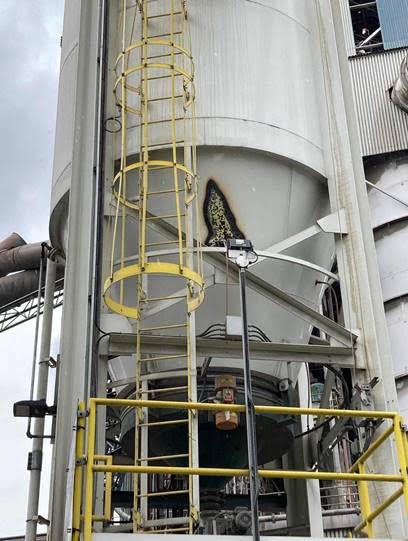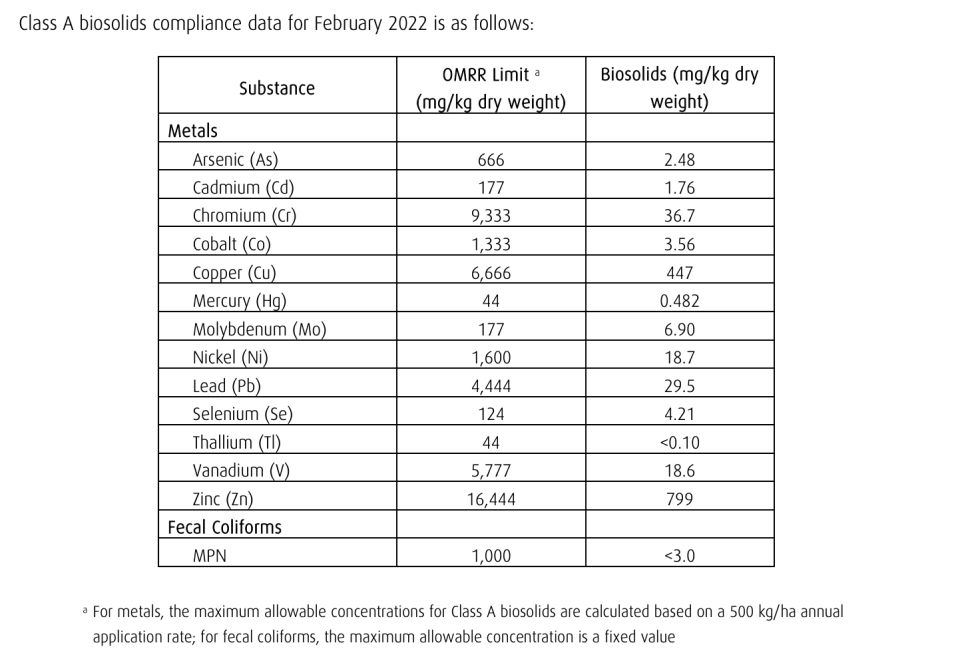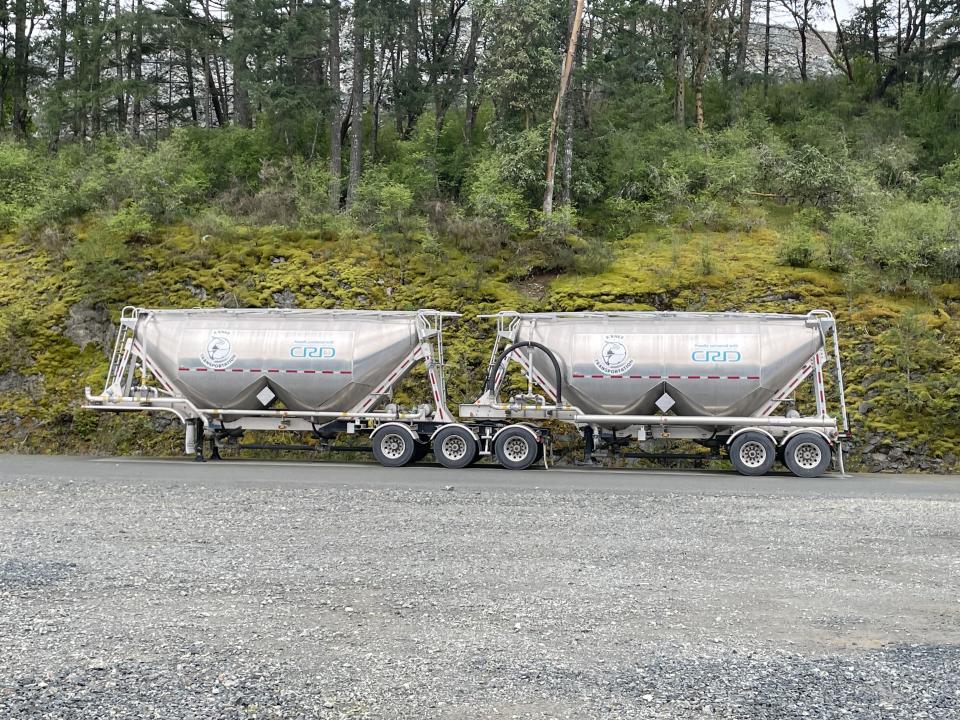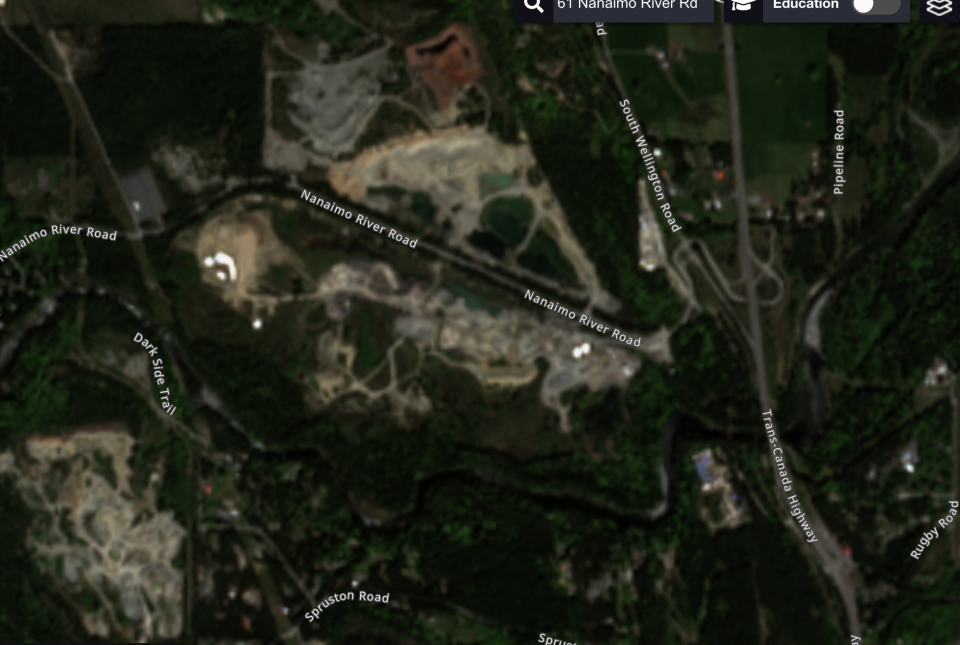Delays, disruptions, fires, and health concerns: CRD's biosolids plan beset with issues
After a series of setbacks and delays, including two fires at the Lafarge cement plant in Richmond, the CRD board approved a biosolids management plan on May 14. The plan comes just in time as biosolids pile up in significant quantities at the Hartland Landfill and in the Cassidy gravel quarry south of Nanaimo. The proposed three-tiered approach will be submitted to the province for approval later this month and by January, they’ll have to implement it.
The first tier of the new long-term plan is to establish an advanced thermal processing plant at Hartland Landfill that will convert biosolids into biochar.
When the proposed processing facility is not available, the CRD will continue to direct biosolids to Cassidy quarry and to Lafarge in Richmond, to be used as an alternative fuel in its cement production process. It is also considering the land application of the biosolids as forest fertilization.
“The long-term goal, of course, is that we are able to actually generate energy and see a return on what we’re getting from our biosolids,” CRD chair Colin Plant said. “Land application is not giving us the best potential return of energy derived from this resource, which is how we’re all choosing to look at this. Biosolids are a resource and we are hoping that we can do better.”
The alternative to “better” is growing piles of biosolids at both Hartland and Cassidy quarry, given that the Lafarge plant has proven to be a far less reliable solution to the mounting issue. The biochar pilot project is not expected to be up and running for at least another two years.
Currently, wastewater from Victoria, Esquimalt, Saanich, Oak Bay, View Royal, Colwood, Langford, and the Esquimalt and Songhees Nations is treated at McLoughlin Point Wastewater Treatment Plant and transported to Hartland’s Synagro facility. There wastewater residual solids undergo mesophilic anaerobic digestion and heat drying which in simpler terms means the solids are treated in digesters at a moderate temperature which results in biogas and approximately 10 tonnes of Class A biosolids per day or 3,650 tonnes per year.
Class A biosolids meet pathogen reduction and vector attraction requirements laid out in the Organic Matter Recycling Regulations of the Environmental Management Act. Class A biosolids are cleared of pathogens, including viruses. Vector attraction are those characteristics biosolids have that attract rodents, flies or other organisms that might feed off them and then, in turn, may carry pathogens or chemicals away from storage sites on their bodies.
And while those regulatory specificities ensure the removal of many potentially harmful pathogens, those regulations do not include provisions for the removal of other harmful elements that persist through these treatment processes that include per-and-polyfluoroalkyl substances (PFAS).
PFAS, otherwise known as “forever chemicals” are contaminants of concern because of their persistence and potential for having negative effects on human health and the environment. Current research shows that these persistent organic compounds can contaminate ground and surface water and their uptake in soil can harm animals and humans.
An InnoTech Alberta report marked “confidential” and prepared as an account of work it conducted on behalf of Capital Regional District in 2019, shows that the CRD has been aware of the hazards of PFASs in biosolids to land and water for more than five years.
Authors of the report, Ataullah Khan Mohammed and Joshua Peng, write the “CRD has banned the land application of sludge biosolids since 2011 amid worries that farmland and the food grown on it could be polluted by pharmaceuticals and heavy metals. However, representatives from Saanich, including chair Colin Plant have, on every occasion, voted in favor of biosolids land application, despite the CRD ban and despite the CRD’s historical awareness of its potential hazards in land application.”
Landfilling biosolids is land application.
Under the CRD’s current plan, after the wastewater is transported to the Synagro facility, the CRD has contracted ḰENES haulage to transport the pellets to three places: the Hartland landfill where they pile up under green tarps, a gravel quarry in Cassidy near Nanaimo, where they pile up under white tarps, and to a Lafarge cement plant in Richmond where the hope was that they would be temporarily stored and then regularly transported and used as an alternative fuel and incinerated in the plant kiln.
However this plan has encountered many obstacles, so instead, a good portion of the14,000 tonnes of these pellets Synagro produces annually remain at the Hartland landfill.
Ideally, biosolids are incinerated along with other fuel sources, like wood waste to create energy. Cement production requires tremendous energy, so more carbon neutral fuels like these are of great value because, in that context, they contribute to reducing C02 emissions. Traditionally, cement companies like Lafarge have used coal, coke, oil or gas in this process. Lafarge, with a western corporate office in Calgary, produces aggregate, cement, ready mix concrete and asphalt. Lafarge has five cement plants in operation across Canada.
Brad Kohl, president and CEO of Lafarge Western Canada said, "The transformation of landfill materials into high-value fly ash for sustainable building presents an exciting opportunity for our customers and us to build more with less and work towards a net-zero future.”
To kick start the strategy, the CRD made a capital investment in Lafarge, in 2022, of $850,000 to build the infrastructure at the Richmond plant that would enable it to receive its biosolids.
Because cement kilns burn at such high temperatures (1,300 to 1,450 celsius), their incineration process further transforms and reduces biosolid contaminants. With temperatures as high as 1,450C they dissipate various wastes and completely decompose or solidify harmful substances in biosolids, including dioxins and heavy metals, in the cement crystal structure. The resulting product can then be used in the production of concrete bricks or as a substrate for road pavement.
The CRD pays Lafarge $500 per ton to do this. It’s a win-win for both sides. The CRD gets to reduce its mounting piles of biosolids and Lafarge gets the kiln fuel. But it’s only a win until something goes wrong.
Why the plan isn’t working
In the past two years, since the CRD began transporting pellets—at 25 tonnes per load—to Richmond, Lafarge has faced a number of challenges ranging from minor mechanical difficulties to the outbreak of two fires that, not only had a significant impact on production there, but also halted the transport of biosolids from Synagro for an extended period of time—until the week of May 21.
An anonymous and confidential source who works at the Hartland landfill—and required anonymity to protect their employment—told Capital Daily that a truckload of biosolids left the Hartland facility on May 24 destined for Richmond. Kirsten Mortsen, communications and marketing manager for Holcim Group (Lafarge’s parent company), confirmed that transports were resuming.
“The Lafarge facility continues to be the priority destination for CRD biosolids under the short-term plan and the agreement with ḰENES Transportation to transport dried biosolids remains active,” said Zoë Gray, CRD corporate communications. However, accidents, the fires, and mechanical issues at the Lafarge facility have occurred, and hampered this arrangement.
The issue that caused the most damage and the longest delay in transports of biosolids between 2022 and now, was a serious electrical fire that erupted in the preheating tower on May 31, 2022.
A YouTube video from that day shows a plume of thick, dark smoke billowing up from the plant. Clay Adams, director of corporate communications and marketing for the City of Richmond described the city’s response to the fire in an email to Capital Daily. “Richmond Fire Rescue personnel responded to a call from the Lafarge plant in Richmond back in 2022, following reports of a fire. Their timely and effective actions ensured the situation was quickly addressed and the blaze was contained and extinguished.”
When asked, in a subsequent email, if biosolids originating from Hartland were burning that day, Adams responded, “With regard to the nature of the materials that caught fire and the reason for them being at the plant, those are questions you need to address directly to Lafarge.” When asked the same question, Andy Orr, senior manager of corporate communications for the CRD, also pointed the finger back at Lafarge.
“I think you should talk to Lafarge for these details, the fire occurred at their facility, and they should speak to it.” After several email and telephone queries to its corporate offices, Lafarge has declined to directly answer whether biosolids were in the preheating tower and burning that day.
In his public statement on the fire, Richmond Fire Chief Jim Wishlove said the fire originated “in a pile of recycled materials at an alternate fuels recycling facility in the area." In one media source, he denies that the fire took place at the plant at all.
However, a Richmond Fire Department incident report on its response to acommercial fire on No. 9 Road on May 31, 2022 says “Crews arrived on scene to a fire in a tower at an industrial plant. Fast action by the first and second arriving units quickly extinguished the fire. After the utilities were locked out, RFR crews carried out a thorough inspection of the fire area to ensure there was no fire extension. The plant sustained considerable damage to the electrical equipment in the burn tower.”
In an email made available to Capital Daily, as part of a request for information about when the CRD board was made aware of the initial fire, Kelly Tradewell, a CRD environmental contaminants officer writing to CRD administrative coordinator - environmental protection Samantha Silva said, “I don’t think we told the board (CALWMC) in any detail what the maintenance shut down was about (there were so many!). This was just another shut down in a slew of past and future shutdowns.”
The May 31 incident does not appear in CRD board June 8, 2022 meeting highlights. Nor does a second fire at the Lafarge facility appear in the board’s Aug 10, 2022 published board meeting highlights. “In regards to the May 31 fire,” CRD staff member Lucas Maslen writes in an email to CRD colleagues, “the fire was reported on the CRD website in June 2022 as an ‘unplanned shutdown.’ The July 17th radio incident was reported as ‘equipment failure’ on the website in the July 2022 update.”
“The radio incident was the result of a radio falling into ḰENES trailer while it was being loaded at Synagro on June 1. The load, with the radio in it, was shipped to Lafarge. Another load of biosolids was shipped on July 16. On July 17, Lafarge reported smoldering in its storage silo and requested [biosolids] deliveries be stopped. On July 18, Lafarge reported the silo was jammed with a radio” writes Maslen.

In responses from Maslen for requests for information from Capital Daily, there is a demonstrable lack of transparency and information-sharing between CRD staff and the board on the nature and impact of the two fires. Maslen writes “I don’t think there were actual flames on July 17th, just that the biosolids got hot and damaged the silo.” He continues, “Neither [of the fires] were reported to the Board as fires, but it was reported that Lafarge was unable to receive [biosolids].” In the photo he provides, the burn marks on the silo are plainly visible.
Therefore, the fire on July 17, 2022 did involve CRD biosolids, but Capital Daily was unable to verify whether CRD biosolids were present and burning at the Lafarge plant in the fire on May 31, 2022. If they were, they certainly would have represented a health and safety hazard to the 100 employees who were on site that day.
Why biosolid fires are hazardous
Mirroring the kiln incineration process, InnoTech Alberta tested Class A biosolids incineration in a laboratory, or drop tube furnace at 1,000C to determine its combustion efficiency, emissions and to generate combustion ash for further testing.
According to InnoTech’s report, the test incineration of the biosolids resulted in the formation of high concentrations of nitrogen oxide (NOx) and sulphur oxide (SOx) emissions on account of its nitrogen- and sulphur-rich composition. The emissions pertaining to NOx, SOx, particulates and chromium (Cr) were found to be in noncompliance with emissions standards of BC adopted air quality objectives and standards.
Chronic inhalation of Cr compounds increases the risk of lung, nasal and sinus cancer. Breathing in sulfur dioxide causes irritation to the nose and throat. Side effects of nitrogen dioxide include dizziness, dissociation, disorientation, impaired memory and cognition and weakness in the legs. If Hartland biosolids went up in the first fire, a number of heavy metals and chemical agents would have been present in the black plume of smoke that bellowed from the Lafarge plant on May 31, 2022 and in the smoke reported by Lafarge in their silo on July 17.
In a CRD biosolids production report, the heavy metals listed in its Class A biosolids include arsenic, chromium, mercury, lead, vanadium and zinc, all of which can be harmful to humans. In their drop tube furnace emissions profile, the authors of the InnoTech combustion study “concluded that the biosolids incineration generated higher than regulated emissions of particulates.”

Many are frustrated at the obstacles and setbacks in the CRD’s biosolids plan
On June 1, 2022, Lafarge informed the CRD of the fire on May 31, 2022 and called off any further loads from Hartland until the facility was operational again. Nowhere on public record is there any reporting on the potential presence of hazardous chemicals at the plant and in the air downwind from it. For the duration of that time period, all Synagro biosolids were subsequently directed into Hartland and the gravel pit at Cassidy.
Gray confirmed, in an email to Capital Daily, “Due to operational and logistical challenges, Lafarge has not been able to receive biosolids for the majority of 2023 and into 2024. They are working on repairs necessary to receive biosolids by the end of May.” She also added that, “Landfilling is not a beneficial use, as per provincial and federal expectations, and consumes valuable airspace at the landfill.”
Capital Daily also asked CRD chair Plant if he thought the partnership with the plant in Richmond was yielding a good return on investment. Plant said “It’s been frustrating that the region has been unable to see its biosolids used consistently at the Lafarge plant.”
The fires and other related shutdowns at Lafarge have so significantly hampered the CRD’s biosolid management plan that even if they were to resume regularly scheduled shipments to Lafarge, they are still left with the challenge of reducing the existing piles at Hartland and Cassidy because of the amount of biosolids processed and produced each month by Synagro.

Former Victoria city councillor and volunteer with the Peninsula Biosolids Coalition Phillipe Lucas, has been raising the alarm about the land-based application of biosolids for years and has denounced the CRD’s lack of transparency with the public on its risks.
In a public statement available online, Lucas calls out what he sees as the consistently contradictory and biased nature of the information the CRD provides the public. He cites a letter written by the minister of the environment and climate change, George Heyman. Heyman, at the time, was the executive director of the Sierra Club. “At a time when the public is more and more supportive of, and aware of, the importance of local food production, the land application of biosolids seems to directly contradict the responsibility of the CRD to protect the region’s farmland, natural environment and public health.”
“One or 2% of CRD biosolids have been sent to Lafarge in the last year,” Lucas told Capital Daily. “The rest of it is either being buried in landfill or it's being shipped out or it's being used for top cover application at Hartland landfill or it's being shipped to the Nanaimo [quarry] for mine reclamation and other uses by Lafarge so there's no question at this point that the CRD is knowingly distributing and moving ahead with land application practices, biosolids that contain PFAS.”
Some say the devil is in the details but the details aren’t very clear
By way of an example of the CRD’s lack of public transparency, biosolids are not represented on a pie chart used in public education efforts by CRD staff at the Hartland landfill to show the different material types present at the landfill. During a tour of the facility, one CRD educator said “it’s because the slide is from 2022.” It’s the same graphic the CRD used in its recent Capital Region District Summary Consultation Report and its presentation to the public on May 8. When the Hartland educator was asked why the biosolids weren’t represented in the graph, she said “because they [biosolids] shouldn’t be here and they need to get them out of here as soon as possible.”
During the most recent provincial budget estimate exchange during the first week of April, Green Party leader Sonia Furstenau interrogated Minister of Environment Heyman on support of land application of Class A biosolids, referring to the letter of concern about them he had written as executive director of the Sierra Club. “Does the minister still have concerns about biosolids being applied to agricultural land?,” she asked.
“I think application to agricultural land is not something that is promoted by my ministry. We think there are other ways to deal with biosolids, because whether we like it or not, we have them,” said Heyman.
And boy, do we have them.
A Hartland employee who required anonymity due to fear of reprisal that could affect their employment told Capital Daily, “They produce way more than what can be disposed of properly. Ten tonnes of biosolids go into Hartland landfill every day.” According to its strategic plan, the CRD is supposed to haul 300 tonnes of Class A biosolids to the Cassidy site every year.
“They take one, two, three truckloads a day sometimes up to Nanaimo, and it doesn't do anything. Then where it goes in Nanaimo gets dumped into a gravel pit and it's just covered with tarps and covered with tarps isn't buried. It's not doing anything and, and it's not far from the Nanaimo River,” the source said.
The CRD refers to this practice as mine reclamation.
Mine reclamation can and does work. The process of mine reclamation can minimize the environmental effects of an extractive project and restore to a more natural ecologically balanced setting. The reclamation project at the Lehigh Sechelt Minecovers 50 discrete hectares of the mine area and has been underway since 1997. The reclamation program has been awarded by environmental groups and government authorities and is “home to a large variety of plants and animals native to the Canadian Northwest coast, including black bear, coyote, elk, deer, cougar, grouse and waterfowl.”
What is happening at Cassidy is altogether different.
“You know they're saying it’s mine reclamation? But it's not reclaiming nothing, it’s dumped on site and it’s being covered with white tarps,” said our anonymous and confidential source. “It's not mine reclamation.”

He described to Capital Daily the overall wariness employees have around the dumping and handling of the biosolids there. “The employees at Nanaimo don’t want anything to do with it. They don’t want to touch it, they don’t want to be near it. The truck that dumps up there is not allowed to wash out because they don’t want it contaminating the ground away from where it’s being dumped.”
It's clear from the Hartland educator on the public tour that employees there don’t want the pellets at Hartland either. “People are not allowed to offload, like chemicals and dump oil into the garbage. There are huge storage containers that have been filled. After that, biosolids have also been landfilled, put in where the garbage goes. And that's the process that we need to stop doing as soon as possible because it's not good practice, it’s taking up space. If rain goes through there that's getting added to the leachate too.”
Leachate is liquid that forms when rainwater is filtered through waste material in a landfill site or a quarry. “They don't want it [the biosolids] because the leachate that comes out is big, black puddles of black water. They didn't accept any in [Cassidy] that they stopped taking in mid-December when it rains and they started taking it again around the end of March,” said the anonymous and confidential source. With time, leachate can contaminate groundwater and contaminate surface and groundwater sources. This requires the constant monitoring of the leachate produced.
Health Canada reports that “many studies have demonstrated that PFAS are transported long distances through the atmosphere, in water bodies and within groundwater.” The Cassidy quarry dumping location is about 230 metres from the Nanaimo River and less than two kilometres from Aquifer 161 and Observation Well 312. Observation Well 312 was included in the well network in 1991. It was established to monitor water levels in developed aquifers in the area.
“While senior CRD staff and the Ministry of the Environment and Climate Change Strategy continue to ignore the overwhelming evidence of unavoidable public health and environmental harms associated with the land application of biosolids, CRD staff, residents and businesses near Hartland landfill continue to be exposed to high levels of contaminants via wind dispersal and rain erosion,” said Lucas from Peninsula Biosolids Coalition.
On March 13, 2024, the CRD Board received correspondence from a member of the public regarding a lawsuit filed in Texas against Synagro. In their suit Farmer v. Synagro Tech., Inc., Texas farmers are seeking damages, including more than $75K after the product was applied to their lands in 2022. In the civil suit, the plaintiffs claim their farms were polluted by toxic chemicals in a biosolids-based fertilizer produced by Synagro after a neighbouring property spread the product on its crops.
CRD staff have met with Synagro executives to obtain more information about the allegations. Synagro confirmed that the biosolids applied to a property in Johnson County between December 2022 and January 2023 were a dried Class A product.
In its March 14 meeting, the CRD board kicked the can down the road a little farther, moving to initiate an academic analysis and “direct staff to move forward with a third-party academic review of the scientific literature on the uses and impacts of biosolids.”
In the meantime, the CRD asked the province for an extension on their submission of its solid waste management plan, but the province rejected the request. CRD board member Jeremy Caradonna confirmed, “I don’t think [the extension] was needed as we landed on a good management plan and the thermal conversion pilot process is moving forward.” However, until the biochar pilot project is up and running in 2026, land application at Hartland and Cassidy remains the status quo whenever Lafarge is unable to accept CRD biosolids.
“Having long ago decided that biosolids are too unsafe to dispose of in our oceans, it is totally irresponsible to ignore a growing body of evidence showing the high potential for harms to our environment and public health associated with land application of biosolids,” said Lucas.
With the recurring challenges it has faced with Lafarge and biosolids deposits mounting at Hartland and Cassidy, the CRD needs a clear, transparent and sure plan moving forward. Its upcoming announcement on June 8 may provide the public with more information about what that plan will be.
Sidney Coles, Local Journalism Initiative Reporter, Capital Daily


